Library
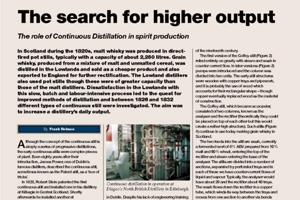 CIBD Membership Required
CIBD Membership Required
The search for higher output
By: Frank Robson
01/04/2007
In Scotland during the 1820s, malt whisky was produced in directfired pot stills, typically with a capacity of about 2,250 litres. Grain whisky, produced from a mixture of malt and unmalted cereal, was distilled in the Lowlands and sold as a cheaper product and also exported to England for further rectification. The Lowland distillers also used pot stills though these were of greater capacity than those of the malt distillers. Dissatisfaction in the Lowlands with this slow, batch and labour-intensive process led to the quest for improved methods of distillation and between 1826 and 1832 different types of continuous still were investigated. The aim was to increase a distillery’s daily output.
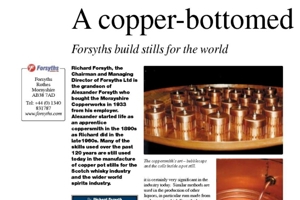 CIBD Membership Required
CIBD Membership Required
A copper-bottomed worldwide business
By: Richard Forsyth
01/04/2007
Richard Forsyth, the Chairman and Managing Director of Forsyths Ltd is the grandson of Alexander Forsyth who bought the Morayshire Copperworks in 1933 from his employer. Alexander started life as an apprentice coppersmith in the 1890s as Richard did in the late1960s. Many of the skills used over the past 120 years are still used today in the manufacture of copper pot stills for the Scotch whisky industry and the wider world spirits industry.
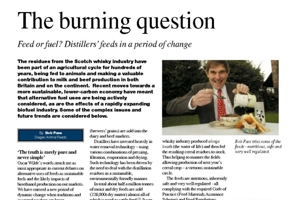 CIBD Membership Required
CIBD Membership Required
The burning question
By: Bob Pass
01/04/2007
The residues from the Scotch whisky industry have been part of an agricultural cycle for hundreds of years, being fed to animals and making a valuable contribution to milk and beef production in both Britain and on the continent. Recent moves towards a more sustainable, lower-carbon economy have meant that alternative fuel uses are being actively considered, as are the effects of a rapidly expanding biofuel industry. Some of the complex issues and future trends are considered below.
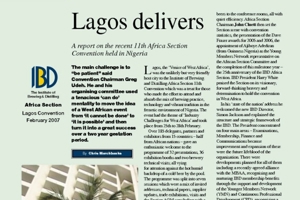 CIBD Membership Required
CIBD Membership Required
Lagos delivers
By: Chris Marchbanks
01/04/2007
The main challenge is to “be patient” said Convention Chairman Greg Udeh. He and his organising committee used a tenacious ‘can do’ mentality to move the idea of a West African event from ‘it cannot be done’ to ‘it is possible’ and then turn it into a great success over a two year gestation period.
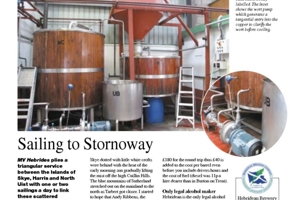 CIBD Membership Required
CIBD Membership Required
Sailing to Stornoway
By: Roger Putman
01/04/2007
MV Hebrides plies a triangular service between the Islands of Skye, Harris and North Uist with one or two sailings a day to link these scattered communities. It is just over 40km from Uig on Skye to Tarbert on Harris and then another 60km by road to the largest town in the Outer Isles – Steòrnabhagh or ‘Stornoway’ – now in very small characters on the Gaelic signposts.
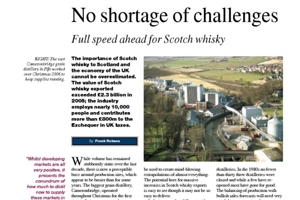 CIBD Membership Required
CIBD Membership Required
No shortage of challenges
By: Frank Robson
01/04/2007
The importance of Scotch whisky to Scotland and the economy of the UK cannot be overestimated. The value of Scotch whisky exported exceeded £2.3 billion in 2005; the industry employs nearly 10,000 people and contributes more than £800m to the Exchequer in UK taxes.
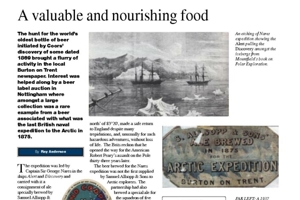 CIBD Membership Required
CIBD Membership Required
A valuable and nourishing food
By: Ray Anderson
01/04/2007
The hunt for the world’s oldest bottle of beer initiated by Coors’ discovery of some dated 1869 brought a flurry of activity in the local Burton on Trent newspaper. Interest was helped along by a beer label auction in Nottingham where amongst a large collection was a rare example from a beer associated with what was the last British naval expedition to the Arctic in 1875.
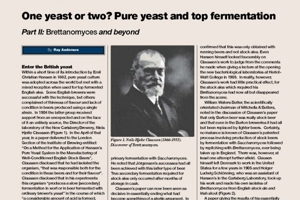 CIBD Membership Required
CIBD Membership Required
One yeast or two? Pure yeast and top fermentation
By: Ray Anderson
01/04/2007
Enter the British yeast: Within a short time of its introduction by Emil Christian Hansen in 1883, pure yeast culture was adopted across the world but met with a mixed reception when used for top fermented English ales. Some English brewers were successful with the technique, but others complained of thinness of flavour and lack of condition in beers produced using a single strain.
 CIBD Membership Required
CIBD Membership Required
Facing the future head on
By: Roger Putman
01/04/2007
The Small Independent Brewers Association (SIBA) was formed back in 1980 when there was a 200 barrel a week minimum on Brewers Society membership. By 1995 the word Small was removed and Society added to make the Society of Independent Brewers, the 200 barrel ceiling was lifted yet the acronym remained the same.
Some of the content requires an active membership to view.
You can find out more here
Some of the content requires an active membership to view.
You can find out more here
